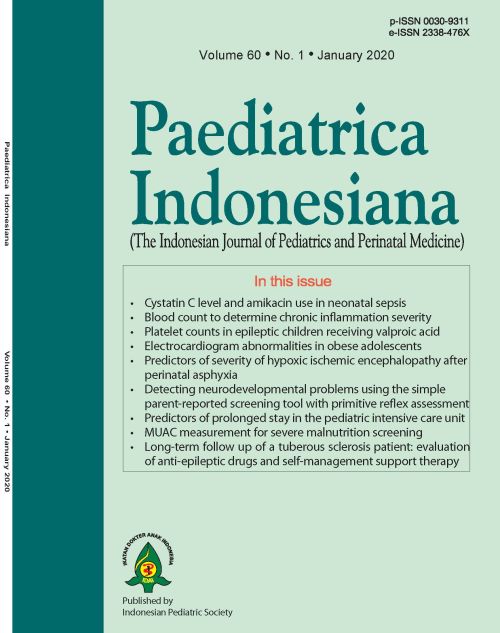Detecting neurodevelopmental problems in children aged 1-5 years using the simple parent-reported screening tool in combination with primitive reflex assessment
DOI:
https://doi.org/10.14238/pi60.1.2020.31-6Keywords:
KPSP; DPsQ; retained primitive reflex; neurodevelopmental problems; children 1-5 years oldAbstract
Background The Kuesioner Pra Skrining Perkembangan/DPsQ (Developmental Pre-screening Questionnaire/DPsQ) is a series of questions and instructions used as a developmental screening tool for children aged 3 months to 6 years. However, the DPsQ cannot fully detect the soft signs of future neurological disorders. However, the retained primitive reflex assessment as an adjunct to the DPsQ may be useful for such detection.
Objective To determine whether assessing for retained primitive reflexes can add to the usefulness of DPsQ as a neurodevelopmental screen in children aged 1 to 5 years.
Methods This cross-sectional study included children aged 1-5 years. Developmental screening was done using the DPsQ and retained primitive reflex assessment was performed using the Institute for Neuro-Physiological Psychology (INPP) screening and scoring guideline.
Results Of 46 subjects, 56.8% of children with normal DPsQ scores had not retained primitive reflexes, while 88.9% of children with suspect DPsQ score had retained primitive reflexes. Hence, children with suspect DPsQ score had a 10.5 times higher chance of retaining primitive reflexes (OR 10.50; 95%CI 1.19 to 92.73; P=0.034). Furthermore, 66.7-77.8% of children with suspect DPsQ score had retained the Moro reflex, asymmetrical tonic neck reflex (ATNR), and symmetrical tonic neck reflex (STNR). Neither gender nor age were significantly associated with either suspect DPsQ score or the presence of retained primitive reflexes.
Conclusion The DPsQ results correlate to integration of primitive reflexes, with 10.50 greater odds of children with ‘suspect’ DPsQ scores to have retained primitive reflexes. As such, retained primitive reflexes is not useful as a primary screen for future neurological problems. However, a high percentage of children (43.2%) with normal DPsQ scores also have retained primitive reflexes.
References
Dhamayanti M. Kuesioner Praskrining Perkembangan (KPSP) anak. Sari Pediatri. 2006;8:9–15. DOI: 10.14238/sp8.1.2006.9-15.
Schott JM, Rossor MN. The grasp and other primitive reflexes. J Neurol. Neurosurg. Psychiatry. 2003;74:558–60. DOI: 10.1136/jnnp.74.5.558.
Arditi PA. Gambaran refleks primitif pada anak dengan dan tanpa gangguan pemusatan perhatian dan hiperaktivitas. Jakarta: Fakultas Kedokteran Universitas Indonesia; 2015. p.5-49.
Blythe SG. Neuromotor immaturity in children and adults: the INPP screening test for clinicians and health practitioners. Chichester: John Wiley & Sons Inc; 2014. p. 32–59. ISBN: 978-1-118-73685-2.
Gallahue DL, Ozmun JC, Goodway J. Understanding motor development: infants, children, adolescents, adults. 7th ed. New York: McGraw-Hill; 2011. p. 461. ISBN-13: 978-0073376509.
Leisman G, Braun-Benjamin O, Melilo R. Cognitive-motor interactions of the basal ganglia in development. Front Syst Neurosci. 2014;8:16. DOI: 10.3389/fnsys.2014.00016.
Leisman G, Melillo R. Effects of motor sequence training on attentional performance in ADHD children. Int J Disabil Hum Dev. 2010;9:275-82. DOI: 10.1515/IJDHD.2010.043.
Blythe SG. Neuro-motor maturity - an indicator of developmental readiness for education. TAC J. 2011;4:1–12.
Melillo R. Primitive reflexes and their relationship to delayed cortical maturation, under connectivity and functional disconnection in childhood neurobehavioral disorders. FNRE. 2011;1:1–36.
Taylor M, Houghton S, Chapman E. Primitive reflexes and attention-deficit/hyperactivity disorder: developmental origins of classroom dysfunction. Int J Special Ed. 2004;19:5-20.
Konicarova J, Bob P. Principle of dissolution and primitive reflexes in ADHD. Act Nerv Super. 2013;55:74-8. DOI: 10.1007/BF03379598.
Bob P, Konicarova J, Raboch J. Persisting primitive reflexes in medication-naive girls with attention-deficit and hyperactivity disorder. Neuropsychiatr Dis Treat. 2013;9:1457-61. DOI: 10.2147/NDT.S49343.
Kementrian Kesehatan Republik Indonesia. Pedoman Pelaksanaan Stimulasi, Deteksi, dan lntervensi Dini Tumbuh Kembang Anak di tingkat pelayanan kesehatan dasar. Jakarta: Kemenkes RI; 2016. p. 29-56.
Zafeiriou D. Primitive reflexes and postural reactions in the neurodevelopmental examination. Pediatr Neurol. 2004;31:1-8. DOI: 10.1016/j.pediatrneurol.2004.01.012.
Aiyejusunle CB, Olawale OA, Onuegbu NF. Association of selected primitive reflex patterns with motor development among Nigerian children with cerebral palsy (a hospital-based study). J Clin Sci. 2016;13:12-6. DOI: 10.4103/1595-9587.175481.
Gieysztor EZ, Choińska AM, Paprocka-Borowicz M. Persistence of primitive reflexes and associated motor problems in healthy preschool children. Arch Med Sci. 2018;14:167-73. DOI: 10.5114/aoms.2016.60503.
Hruska R. Recent course question: is it the assyemtrical tonic neck reflex (ATNR) ever fully integrated, or is it constant presence throughout our lives? [Internet] [cited 2019 June 30]. Lincoln: Postural Restoration Institute [cited on 2019]. Available from: https://www.posturalrestoration.com/community?os=50&year=2016.
Brain Sync. A primitive reflex integration program [Internet]. New York: Brain Sync [cited on 2019 June 30]. Available from: http://www.brain-sync.net.
Bangalore L. Brain development. 1st ed. New York: Chelsea House Publishers; 2007. p. 103. ISBN: 0791089541.
Hadders-Algra M, Towen B. Minor neurological dysfunction is more closely related to learning difficulties than to behavioral problems. J. Learning Disab. 1992;25:649-57. DOI: 10.1177/002221949202501004.
Downloads
Published
How to Cite
Issue
Section
License
Authors who publish with this journal agree to the following terms:
Authors retain copyright and grant the journal right of first publication with the work simultaneously licensed under a Creative Commons Attribution License that allows others to share the work with an acknowledgement of the work's authorship and initial publication in this journal.
Authors are able to enter into separate, additional contractual arrangements for the non-exclusive distribution of the journal's published version of the work (e.g., post it to an institutional repository or publish it in a book), with an acknowledgement of its initial publication in this journal.
Accepted 2020-02-06
Published 2020-02-06


















